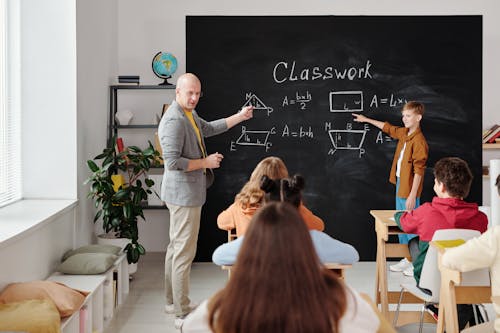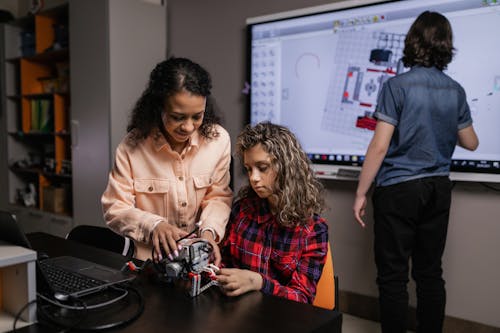Scaffolded Instruction to Build Foundational Skills
Think back to when you learned to read. Did you begin by learning about letters and letter sounds, or did you jump into reading novels? Most likely, you had a teacher or adult guiding you in learning the basics of phonics before attempting more challenging word reading. This process of progressing from foundational skills to more advanced with appropriate support is known as scaffolding. You’ve probably heard this term used before, and you’ve also probably utilized elements of scaffolding in your own classroom without even realizing it. Scaffolding is a powerful way for teachers to help their students become confident and independent learners, as well as meet necessary learning goals. Whether you teach first grade or high school, all students benefit from effective scaffolding in order to retain information and progress as learners.
What is Scaffolding?
The term “scaffolding” is a modern-day revival of Lev Vygotsky’s idea of a student’s “zone of proximal development.” In short, Vygotsky proposed that there is a range between what a student can do independently, what they can do with teacher support, and what they cannot yet do. By identifying this zone, teachers can determine the level of support a student needs as they move towards mastering new skills.
In 1976, Wood, Bruner, and Ross introduced the term “scaffolding.” They defined it as a process that “enables a child or novice to solve a task or achieve a goal that would be beyond his unassisted efforts.” As a student begins to complete tasks independently, earlier supports are slowly removed. By identifying a child’s zone of proximal development and integrating methods of scaffolding, teachers can provide their students with appropriate support to meet the learning objectives of diverse learners.
Scaffolding vs. Differentiation
With so many buzzwords being used in the education world, it’s easy to confuse one with another. Scaffolding and differentiation are both techniques that teachers can use to help students progress from one level of learning to the next. However, these terms are very different, and it’s important to understand why.
While scaffolding refers to the process of delivering material in manageable chunks with appropriate support, differentiated instruction is about modifying the lesson to meet different learning styles and needs. To differentiate a lesson, teachers may need to adjust text size, pair vocabulary words with images, or modify the length of a writing assignment. Simply put, scaffolding involves providing supports that guide developing learners into reaching a more complex goal, while differentiation involves tailoring instruction and content to the needs of individual students. All students can benefit from scaffolding, but specific students may require a learning environment with differentiated instruction.
What does it look like?
Scaffolding can look very different depending on the age of the students and the subject being taught. Here are a few examples of what scaffolding might look like in a variety of subjects.
Language Arts

An effective way to scaffold reading or writing lessons is by front-loading (or pre-teaching) vocabulary words. Students are much more likely to continue reading a challenging book or passage if they already have an understanding of some of the more advanced or unknown vocabulary words. A fun way to front-load vocabulary is to pair images with words, and then let students play a memory or matching game with the words and images.
Another scaffolding technique that can be used in language arts lessons is providing students with rubrics or examples of the product you are asking them to create. For example, if students are writing a persuasive essay, give them a rubric detailing which elements are needed to create an effective persuasive writing piece. If students are illustrating an alternative book cover for a book they’ve read, show them an example of what that might look like. Providing students with clear expectations and examples will help to support them in completing assignments.
Math & Science Classes

An effective scaffolding technique that works well in math or science lessons is activating students’ prior knowledge. It can be challenging for a teacher to begin teaching a new concept if they don’t know what skills and knowledge students already have. By giving students time to journal or have “turn & talk” discussions with small groups, teachers can make an informed decision about where to begin their instruction. Once teachers have established this baseline, they can continue to implement additional scaffolding techniques in subsequent lessons.
Diagrams, charts, and graphic organizers are used frequently in both math and science classes. These visual aids actually happen to be very powerful scaffolding tools! By pairing visual representations with verbal instructions, teachers are appealing to a range of learning styles. Graphic organizers can be used to aid students in organizing their thoughts when learning a new concept. These organizers might look like Venn diagrams, KWL charts, or cause and effect charts. Once complete, students can use these graphic organizers as support in writing reports or organizing data.
Tech

Teaching tech skills such as coding, digital citizenship, or keyboarding can be challenging, especially with younger students. One effective way to scaffold these skills is through modeling. When a teacher models an activity, students can follow along step by step. For example, if a teacher is guiding students through a coding lesson, having them follow along to practice connecting coding blocks or writing code with support is important before assigning independent coding projects.
Keyboarding

The Typing.com curriculum has elements of scaffolding built into each grade level progression. Visuals are important in demonstrating correct hand placement when students are learning to type. The virtual keyboard shown at the bottom of each typing screen helps students to visualize where to place their hands without actually looking at their fingers. Videos are also used when new keys are introduced to provide further guidance and support on the correct way to type them.
In each unit, typing skills will build on what was learned in the previous lessons. Students begin their Typing.com journey by learning the correct typing technique for each key. Once they have a basic understanding of how to navigate the keyboard, they apply this knowledge towards typing longer words, sentences, and paragraphs. By the end of the curriculum, students in 2nd through 12th grades are prepared to create their own unique content in the creative writing unit.
Integrating scaffolding in learning for your entire class may take some additional time at first, but your effort will benefit a wide range of learners. And while it may seem counterintuitive to slow students down with scaffolding techniques initially, know that these supports will eventually help them progress more independently in the future. Think of scaffolding as the support structure your students need in order to become confident critical thinkers and problem solvers.

